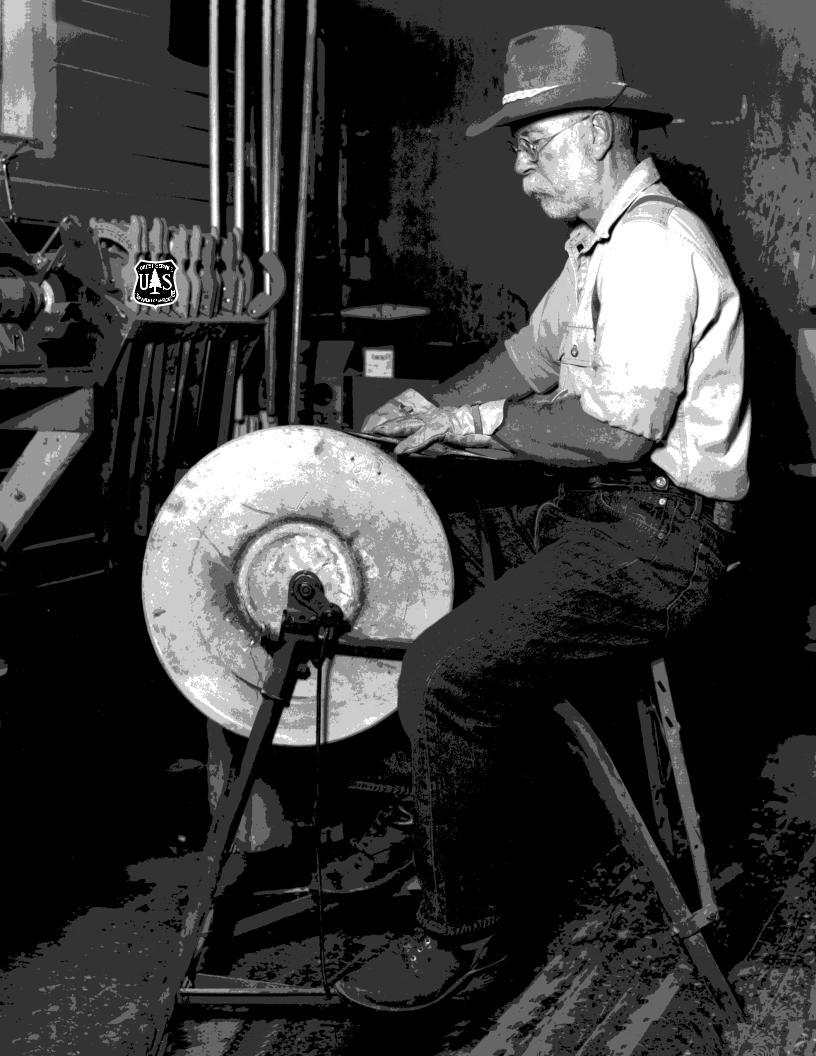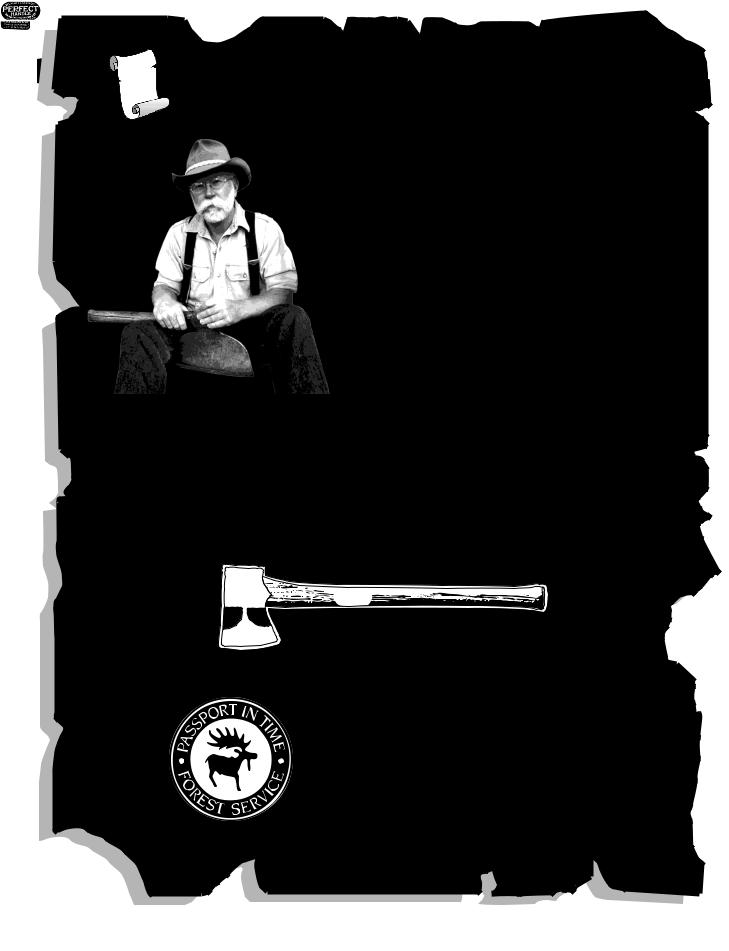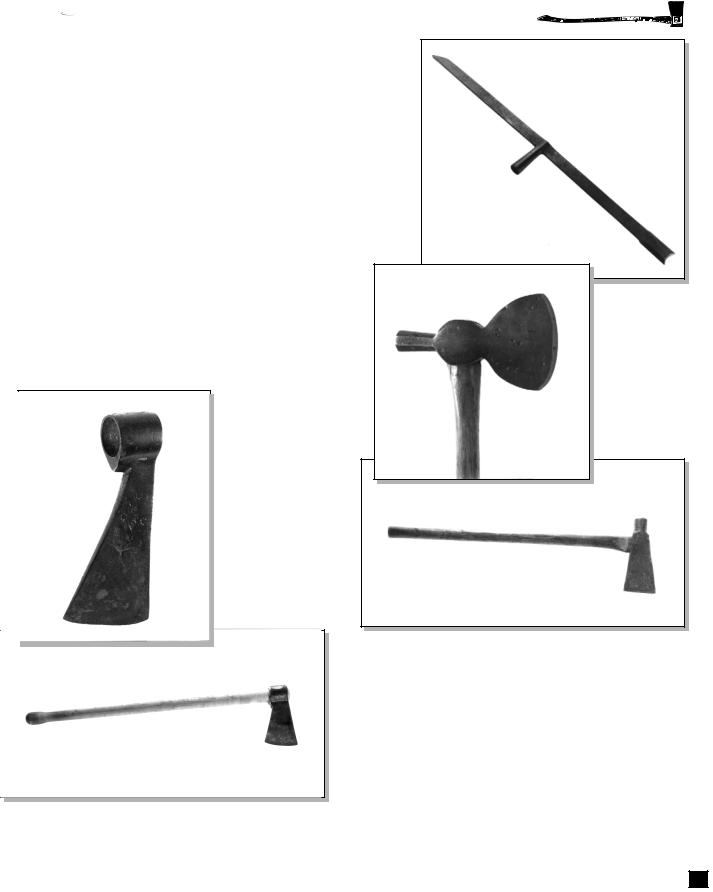
An Ax to Grind - A practical Ax manual
.pdf
Unitedit Statest t
Departmentrt t off
Agricultureri lt re
Forestt Servicei
Technologyl &
Developmentl t
Program
2300 Recreationr ti Julyly 1999
9923-2823P-MTDC
An Ax to
Grindi
A Practicalr ctic l Ax Manuall












 A
A

 bout the Author
bout the Author
Bernie Weisgerber is a historic preservation specialist for the USDA Forest Service. He has been in charge of the Northern Region’s Historic Preservation Team, headquartered in Missoula, MT, since 1991. He worked for the National Park Service’s Historic Preservation Training Center before coming to
work for the Forest Service.
Bernie and his crew of skilled craftsmen restore historic Federal buildings, often at remote sites, using traditional technologies
and materials. The team’s projects often provide training opportunities for other Federal employees and the general public, as part of the Forest Service’s Passport in Time and Heritage Expeditions programs. Weisgerber has twice been a guest craftsman on National Public Broadcasting’s This Old House television series.
My Favorite Ax
Passport in Time and Heritage Expeditions are part of the USDA
Forest Service’s Heritage Program that allows the public to explore the
past on their national forests.

An Ax to 



 Grind
Grind 















A Practical
Ax Manual
Bernie Weisgerber
Author
Brian Vachowski
Project Leader
USDA Forest Service
Technology and Development Program
Missoula, MT
8E82A42—Ax Manual/Video for Heritage Site Restoration
July 1999
The Forest Service, United States Department of Agriculture, has developed this information for the guidance of its employees, its contractors, and its cooperating Federal and State agencies, and is not responsible for the interpretation or use of this information by anyone except its own employees. The use of trade, firm, or corporation names in this publication is for the information and convenience of the reader, and does not constitute an endorsement by the Department of any product or service to the exclusion of others that may be suitable. The United States Department of Agriculture (USDA) prohibits discrimination in all its programs and activities on the basis of race, color, national origin, sex, religion, age, disability, political beliefs, sexual orientation, or marital or family status. (Not all prohibited bases apply to all programs.) Persons with disabilities who require alternative means for communication of program information (Braille, large print, audiotape, etc.) should contact USDA’s TARGET Center at (202) 720–2600 (voice and TDD). To file a complaint of discrimination, write: USDA, Director, Office of Civil Rights, Room 326-W, Whitten Building, 1400 Independence Avenue SW, Washington, D.C. 202509410, or call (202) 720–5964 (voice and TDD). USDA is an equal opportunity provider and employer.

T able of Contents
able of Contents
Acknowledgments___________________________________________________________________ v
Brief History of the Ax _____________________________________________________________ 1
Evolution of the Ax in America _____________________________________________________________ 1 Ax Types, Patterns, and Uses ______________________________________________________________ 4 American Felling Ax ________________________________________________________________________ 7 Double-Bit Ax ______________________________________________________________________________ 8 Broad Ax ___________________________________________________________________________________ 9 Other Axes and Hatchets __________________________________________________________________ 10 Adzes _____________________________________________________________________________________ 13 Decline of the American Ax _______________________________________________________________ 14
Getting the Hang of It _____________________________________________________________17
Basics of Handle Selection ________________________________________________________________ 19
Hanging Procedure _______________________________________________________________________ 21
Sharpening _______________________________________________________________________________ 27
Using Axes _________________________________________________________________________33
A Most Versatile Tool _____________________________________________________________________ 33 Using an Ax Safely ________________________________________________________________________ 33 Chopping Technique ______________________________________________________________________ 35 Felling Trees ______________________________________________________________________________ 38 Limbing __________________________________________________________________________________ 41 Cutting Pinned-Down Saplings ____________________________________________________________ 42 Bucking __________________________________________________________________________________ 42 Splitting __________________________________________________________________________________ 44 Hewing ___________________________________________________________________________________ 45
Buying an Ax_______________________________________________________________________51
New and Used Axes _______________________________________________________________________ 51
Manufacturers ____________________________________________________________________________ 51
Distributors ______________________________________________________________________________ 53
Organizations _____________________________________________________________________________ 55
Selected References _______________________________________________________________57
ii

A cknowledgments
cknowledgments
From the time this manuscript began as a series of audio tapes, An Ax to Grind: A Practical Ax Manual has benefited from a lot of assistance. I would like to thank the following Missoula Technology and Development Center staff and other Forest Service employees for their
major contributions.
John Alley (Northern Region) |
Printing |
Bob Beckley |
Photography |
Michelle Beneitone |
Text processing |
Ted J. Cote |
Design and layout |
Gary Hoshide |
Review |
Jim Kautz |
Photography |
Bert Lindler |
Editing |
David Michael (Apache-Sitgreaves National Forest) |
Review |
Brian Vachowski |
Project Leader, |
|
research, writing, |
|
editing |
Gloria Weisgerber (Northern Region) |
Review |
Mark Wiggins |
Photography |
Jerry Taylor Wolf |
Research, editing |
I would also invite you to look at the companion video program, An Ax to Grind. Parts 1 and 2 of the program are each 30 minutes long. Copies are available from MTDC at the address on the inside of the back cover.
Many of the photographs are of axes from Bernie Weisgerber’s personal collection. Many of the illustrations were drawn by Frederic H. Kock for Bernard S. Mason’s book, Woodsmanship (1954). The illustrations are used here by permission of Mrs. Frederic H. Kock.
iii

iv

B rief History of the Ax
rief History of the Ax
I’ve always had a passion for axes. I received my first ax—a toy—when I was 8 years old, and my first real ax not long afterwards.
Since that time, for over 45 years, I’ve used and collected all kinds of axes and adzes in my professional work restoring historic buildings and structures.
We cannot explore everything there is to know about axes in this publication. What I would like to share with you is a brief background on the development of axes, the hanging and sharpening of axes, how to use an ax, and detailed information on certain ax patterns. I’ve tried to place the discussion within the context of working with axes today and from a historical perspective of their use within the USDA Forest Service.
In An Ax to Grind: A Practical Ax Manual, you’ll find:
•A brief look at the history of the ax, especially its evolution in America
•Types and patterns of axes and adzes, showcasing some examples from my personal collection and some from old catalogs
•How to hang and sharpen an ax, two essential skills for anyone using an ax
•Various examples of using axes, incorporating historical material
•Where to buy a good ax
•Some other good references about axes that you may find useful.
This manual is intended to be a companion to my video program, An Ax to Grind (99-01- MTDC). The video (Figure 1) was produced by the Missoula Technology and Development Center (MTDC). Copies are available from the center. I hope you’ll take a look at it.
Figure 1—The video program, An Ax to Grind (99-01-MTDC), is a companion to this manual. The video is available from Missoula Technology and Development Center.
Evolution of
the Ax in America
...having an ax to grind
Getting even for a perceived wrongdoing.
...barking your knuckles
Scraping your knuckles on the side of a log while hewing it.
...can’t get the hang of it
Can’t get it right, originally referring to the way an ax handle was mounted to the ax head.
1

 Brief History of the Ax
Brief History of the Ax
Although we still make references to axes in our daily speech, most Americans have a limited knowledge about them (Figure 2), including how to use and properly maintain them. But the ax, in one form or another, has been around for over 10,000 years—even longer if you consider some of the crude stone tools used as axes by early man.
Figure 2—Barking your knuckles comes with the territory when you choose to hew logs with a broad ax.
While the ax has gone through transformations from stone, copper, bronze, and iron to steel, its overall shape and function have remained consistent (Figure 3). The ax was the first real woodworking tool, one of only a few available for a long period. For centuries the ax was one of mankind’s most useful tools.
The early iron and steel axes used in America had European roots. Henry J. Kauffman, in his introduction to American Axes (1994), wrote:
Part of the problem of focusing attention on the American axe arises from the fact that the earliest ones used here were made in Europe, and certainly the first ones made here were European in character. Thus, in the earliest colonial times a dividing line could not be drawn between the two catego-
Parts of the Axe
Figure 3—Parts of the ax. (Courtesy of Gränsfors Bruks AB, Sweden.)
ries. As a matter of fact, the object was really a European-American axe. Because iron, unlike wood, is similar regardless of the place it was made, the essential substance of an axe does not help to identify its origin. Short of some identifiable maker’s mark, the manufacturers of most of our early axes must remain anonymous.
It seems certain that most of the first axes made in North America were made and used on the Atlantic seaboard, a few exceptions occurring when trading companies brought in blacksmiths to their centers of exchange to repair and resharpen axes. As settlers moved westward and southward, their needs were supplied by smiths who went with them and were responsive to individual needs. This procedure was the beginning of very high specialization in the forms of axes, a differentiation which was picked up by the big manufacturers in the nineteenth century. The axes were mostly of the felling variety, but there were other purposes for which an axe was needed.
2

The pace of specialization increased; as evidence of this trend, one manufacturer informed the writer that at one time the company manufactured about three hundred different types. The president of the Mann Edge Tool Company, in Lewistown, Pennsylvania, reported that in 1969 they were producing seventy different patterns; however, the bulk of their production involved only about twenty.
The ax became quite specialized in Europe during the Middle Ages and afterward. When European colonists dispersed throughout the New World, they brought their tools and their knowledge with them. It is not surprising to see the appearance of trade axes (Figures 4 and 5) and Germanic goose-wing hewing axes. We also see examples of older European-style specialized axes (Figures 6, 7, and 8) in America.
Figure 4— A 17thcentury trade ax, typically made in northern Spain and traded by the French with American Indians.
Brief History of the Ax 
Figure 6— An 18thcentury mortising ax or twibil gives an idea of the specialization apparent even in early axes. Length,
4 feet.
Figure 7—An 18th-century shingling hatchet is another specialized ax. Ax head is 51/2 inches long by 4 inches wide.
Figure 5—An early 20th-century Collins ax manufactured for the South American market. Note the similarity in design of the two axes.
Figure 8—An 18th-century splitting ax, with straight handle typical of early axes.
Americans modified European axes for two principal reasons (Kauffman 1994). First, the European axes were not as well suited to the virgin stands of huge trees found in America as they were for the smaller timber stands of Europe. The European axes were good tools for hewing, but less adequate for felling. The second reason, Kauffman suggests, is that many of the Europeans who left their homelands for an uncertain future in America were prepared
3

 Brief History of the Ax
Brief History of the Ax
to adapt to survive. Their pioneering spirit bred ingenuity.
The need for a better felling ax, the need to process huge amounts of timber during America’s settlement, and American ingenuity made development of the American felling ax inevitable.
We no sooner got started on this book than confusion over
terminology set in. The simplest term to decide was “ax” instead of “axe.” Although most historical sources go with axe, we chose ax because that spelling is preferred in the Government’s style manual. More problematic was the correct term for a single-bit ax. We found single-bit axes described as a single-bit ax, felling ax, American ax, and pole ax. Although woods workers commonly refer to a single-bit ax as a pole ax, dictionaries refer to the pole ax as a medieval battle ax, an ax that’s quite a bit different than the axes we are writing about. Pole ax probably refers to the poll (steel counterweight) on the back of the head of a modern single-bit ax. The trade axes that preceded the single-bit ax did not have a poll. The American ax and felling ax have slightly different meanings to me, so we compromised on single-bit ax throughout most of the text. Whether or not single-bit axes should be hyphenated is yet another story. We chose to rely on a modern dictionary for the spelling.
Ax Types, Patterns, and Uses
During the 19th century, America’s agrarian society was not as mobile as our society is today. People lived their lives in relatively small geographic areas. This is one explanation of the hundreds of different ax-head patterns that developed over the last 150 years.
The individual skills of local blacksmiths and their view of what an ax needed were important factors in the development of ax-head patterns. Ax patterns became a matter of regional preference.
Around the turn of the 19th century, more than 300 different ax-head patterns were being manufactured in the United States. Many were nearly identical. To simplify identification and eliminate unnecessary or duplicate patterns, the Ax Manufacturers’ Association agreed to set a standard, which resulted in a standard chart of ax patterns (Figure 9).
Certain ax patterns become popular within a given geographic area, such as the Jersey (my particular favorite), the Michigan, the Dayton, and the Kentucky (Figure 10). At times, ax head patterns included a name that related to their use. For example, the rafting ax pattern originated in the day when logs were rafted down rivers.
Ax-head patterns were also adapted to the timber that was available in the local area. The double-bit ax was originally developed in Pennsylvania (Figure 11). But the double-bit axes with a long, narrow, heavy ax head and a long handle, were developed for cutting large trees in the Pacific Northwest. Some of the patterns from this area were the Puget Sound, the Young’s felling pattern, the Redwood pattern, and the Humboldt pattern.
4
